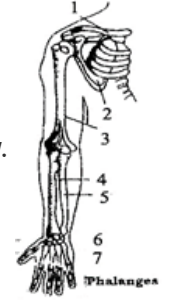
In the given diagram of the right pectoral girdle and upper arm, a few structures are marked as 1, 2, 3, 4, 5, 6, and 7. Identify the marked structures from the options given below.

A. 1-1st vertebra, 2-Scapula, 3-Humerus, 4-Radius, 5-Ulna, 6-Carpals, 7-Metacarpals
B. 1-Scapula, 2-Clavicle, 3-Humerus, 4-Radius, 5-Ulna, 6-Carpals, 7-Metacarpal
C. 1-Ilium, 2-Scapula, 3-Humerus, 4-Humerus, 5-Ulna,6-Carpals, 7-Metacarpals
D. 1-Clavicle, 2-Scapula, 3-Humerus, 4-Radius, 5-Ulna, 6-Carpals,7-Metacarpals

Answer
344.7k+ views
Hint:
Our body constitutes of joints, muscles, and structures that connect one bone to the next. A pectoral girdle connects the upper limbs to the bones along the axis of your body.
Complete answer:
The two bones clavicle and scapula constitute the pectoral girdle that makes up the shoulder. The pectoral girdle provides structural support to the shoulder regions on the left and right sides of the body.
The clavicle bone looks like S in shape and is located at the foremost part of the body in a horizontal position. The scapula bone or shoulder blade is located at the back of the shoulder. It’s triangular and connects the humerus with the clavicle. The humerus is the longest upper arm bone. It begins from the shoulder and scapula to the elbow. The radius and ulna are long bones that make up the forearm and extend from the elbow to the wrist. The carpal bones are the wrist bones that connect the radial and ulna bones of the forearms to the bases of the hand. The hand contains five metacarpal bones that articulate proximally with the carpals and distally with the proximal phalanges.
Hence the correct answer is 1-Clavicle, 2-Scapula, 3-Humerus, 4-Radius, 5-Ulna, 6-Carpals, 7-Metacarpals.
Option ‘D’ is correct
Note:
The clavicle supports the shoulder, encourages a full range of motion, and protects nerves and blood vessels that pass between the trunk of the body and upper limbs.
Our body constitutes of joints, muscles, and structures that connect one bone to the next. A pectoral girdle connects the upper limbs to the bones along the axis of your body.
Complete answer:
The two bones clavicle and scapula constitute the pectoral girdle that makes up the shoulder. The pectoral girdle provides structural support to the shoulder regions on the left and right sides of the body.
The clavicle bone looks like S in shape and is located at the foremost part of the body in a horizontal position. The scapula bone or shoulder blade is located at the back of the shoulder. It’s triangular and connects the humerus with the clavicle. The humerus is the longest upper arm bone. It begins from the shoulder and scapula to the elbow. The radius and ulna are long bones that make up the forearm and extend from the elbow to the wrist. The carpal bones are the wrist bones that connect the radial and ulna bones of the forearms to the bases of the hand. The hand contains five metacarpal bones that articulate proximally with the carpals and distally with the proximal phalanges.
Hence the correct answer is 1-Clavicle, 2-Scapula, 3-Humerus, 4-Radius, 5-Ulna, 6-Carpals, 7-Metacarpals.
Option ‘D’ is correct
Note:
The clavicle supports the shoulder, encourages a full range of motion, and protects nerves and blood vessels that pass between the trunk of the body and upper limbs.
Recently Updated Pages
What is glandular epithelium class 11 biology NEET_UG

The common characteristics between tomato and potato class 11 biology NEET_UG

Master Class 12 Business Studies: Engaging Questions & Answers for Success

Master Class 12 Economics: Engaging Questions & Answers for Success

Master Class 12 English: Engaging Questions & Answers for Success

Master Class 12 Maths: Engaging Questions & Answers for Success

Trending doubts
What is BLO What is the full form of BLO class 8 social science CBSE

Which places in India experience sunrise first and class 9 social science CBSE

Differentiate between an exothermic and an endothermic class 11 chemistry CBSE

The shortest day of the year in India

What are the major means of transport Explain each class 12 social science CBSE

Which are the Top 10 Largest Countries of the World?




